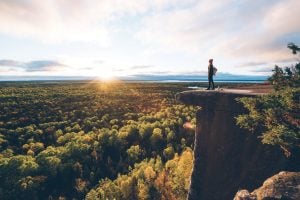
Travel
How to stop a gold rush
The new movement building flourishing tourism hubs across Canada – one sustainable example at a time
- 3297 words
- 14 minutes
This article is over 5 years old and may contain outdated information.
People & Culture

Postcard images of Nova Scotia accent either the granite slag-heap coastline of Peggy’s Cove or Cape Breton’s cliff-hugging Cabot Trail. But when I was a “coloured” kid growing up in Halifax’s rough-and-tumble North End (all pavement and smashed glass and malice-eyed cops and pink-faced drunks), I felt immeasurably blessed. I knew that, 40 minutes away by car, bus or train, there was a grassy apple-blossomed paradise, the “Gateway to the Annapolis Valley,” the town of Windsor. Just southeast of it was Three Mile Plains, a black Eden where my mother’s parents lived.
Three Mile Plains is also — ecumenically — “Five Mile Plains” and “Windsor Plains.” Not flat, it’s several loping kilometres of rolling slope upon which folks farm, raise cows and horses and allow hay to explode skyward.
My mother’s people — the American slaves liberated by the British during the War of 1812 — arrived in coastal Nova Scotia in 1813. A generation later, they moved inland, perhaps to join a larger black community, to Three Mile Plains. There, blacks were granted too little land — deliberately — to become farmers. So they toiled in gypsum quarries and in white people’s homes to eke out livings. Some of them, including my maternal relatives, intermarried with the Mi’kmaq. They also erected a church, Windsor Plains (African) United Baptist, and attended the segregated (until 1956) one-room Three Mile Plains School.
Acadia University reported in 1965 that most Three Mile Plains adults had only an elementary-school education. However, my mother, Geraldine Elizabeth Johnson, graduated from teachers’ college and my father, Bill Clarke, is a self-taught polymath, so when I was born in 1960 (my mother matching my initials to her own), they ensured that I received the best public education available.
My formal schooling was gilded by visits to unpaved Green Street, which bisects Three Mile Plains, and my grandparents’ two-storey, white wooden house — with ocean-sounding conch shell doorstops and a veranda — and what seemed an expansive, dandelioned and willow-treed sloping front lawn. I loved their antique wood stove and the smells of burning wood crackling in the blue dawns and the Sunday supper riches from their garden: carrots, cucumbers, lettuce, cabbage, potatoes. They even had a pear tree and a crabapple tree. The cheek-by-jowl woods, approached via tall fields of hay, sprouted trickily thorny blackberry and raspberry bushes along their fringe and brandished hazelnut bushes among pine, birch, spruce, alder and maple trees. A footpath plunged and twisted through the woods down to the iron tracks that bore freight and passengers through the valley, the train horns blaring whoo, whoo as they trundled past us, leaving a fragrant — to a child — whiff of diesel fuel in the air.

I was a bookish boy. I thrilled to know that the Mi’kmaq deity, Glooscap, presided over Blomidon — only some 30 kilometres west — and that Henry Wadsworth Longfellow’s tragic Acadian heroine, Evangeline, had wept, Ruth-like, amid the “unalien” marsh of Grand Pré. I adored a memorial at Hantsport to William Hall, the third Canadian — and first black — to win the Victoria Cross. I knew that English Canada’s first great writer, Thomas Chandler Haliburton, had lived near Windsor’s Shakespeareanly named Avon River.
For me, the intense, infernal beauty of Three Mile Plains and the Annapolis Valley is a fount of emotional history and heart-startling poetry: “Arcadia.”
I’d begun to craft poetry — unmusicked “songs” — when I was 15, and Three Mile Plains was their locus. The day I became incontrovertibly, irremedially a poet was February 12, 1977, my 17th birthday, when my mother and I drove to Three Mile Plains on a sunny, frigid, snowy morning. That day, as I trudged up and down hilly, white-dusted Green Street, I drafted in my head a poem, my first attempt to sing a black and Nova Scotian — an Africadian — consciousness. With my breath hanging clear in front of me, I claimed my Afro-Mi’kmaq heritage. I was standing on land that has always made us feel whole.
When my mother passed away in August 2000, my two brothers and I inherited her Three Mile Plains property. Walking there, I feel as thought I’m traversing a little northern fragment of Africa. Promised land.
Are you passionate about Canadian geography?
You can support Canadian Geographic in 3 ways:

Travel
The new movement building flourishing tourism hubs across Canada – one sustainable example at a time

People & Culture
The story of how a critically endangered Indigenous language can be saved

History
A look back at the early years of the 350-year-old institution that once claimed a vast portion of the globe

Kids
The Canadian Geographic Challenge, now in its 20th anniversary year, will bring 20 young…